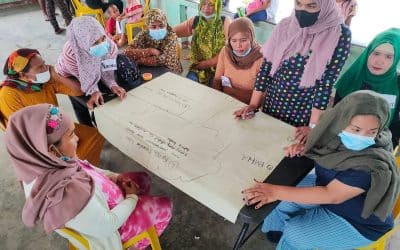InAsia
Insights and Analysis
Mongolia’s Capital Copes with Rapid Urbanization
May 31, 2017
In the Mongolian capital city of Ulaanbaatar, urbanization has become one of the country’s most critical development issues. The days when construction cranes filled Ulaanbaatar’s skyline and buildings would appear to grow overnight are a thing of the past. Though Mongolia experienced unprecedented growth between 2011 and 2013, where GDP reached record levels of 17.3 percent, a combination of factors, including lavish government spending and the decline of revenue from commodity exports, have halted the country’s GDP growth to 1 percent in 2016.

Recent statistics estimate that the ger area is now home to 800,000 residents, or 60 percent of Ulaanbaatar’s total population. Photo/Mark Koening
Despite this economic downturn, urbanization of Ulaanbaatar continues unabated, as the capital’s population has grown by 70 percent in the last 20 years. A range of push-and-pull factors continue to influence migration from the steppes to the capital. Among other influences, these include Mongolia’s 1994 Land Law, which entitles every Mongolian to 0.7 hectares of land within the limits of urban centers, free of charge, for a term of 15-60 years; employment and education opportunities; the perceived improved living conditions of cities; and the loss of herders’ livestock due to Mongolia’s harsh winters, also known as dzud. A dzud is characterized as a natural disaster phenomenon, unique to Mongolia, where summer droughts combine with harsh winters, that result in significant livestock loss from either starvation or cold.
Today, Ulaanbaatar accounts for more than 40 percent of the country’s three million inhabitants, with the city’s total administrative area now 30 times larger than the original area it was built on. In recent times, migrants from the countryside are settling in the ger areas, which have become sprawling, unplanned neighborhoods vulnerable to natural disasters such as flash floods. The ger areas often lack access to improved sanitation services, including water, and have poor connectivity to the city’s electrical grid, central sewage, and heating systems.
In 2017, the mayor of Ulaanbaatar passed a decree in response to the mass influx of migrants to restrict migration to the city until 2018. This initiative aims to prevent outward growth of the ger areas by halting the construction of new settlements and by prohibiting the expansion of electrical lines and water pipelines. Despite this initiative, which has divided public opinion, a future challenge is the potential rise of unregistered inhabitants, ineligible and unable to access basic social services such as education and health care.
Recent statistics estimate that the ger area is now home to 800,000 residents, or 60 percent of Ulaanbaatar’s total population. Only 10 percent of these areas have paved roads, which poses challenges related to public transportation, health services, and access to schools. Hazardous pollution in Ulaanbaatar, which in December 2016 reached higher PM levels than concurrent data recorded in Beijing, poses another problem for residents. The mean household income in the ger areas is close to half of those living in non-ger (i.e., mixed or apartment) areas.
While ger areas were once considered temporary settlements, these unplanned communities are centralizing, and absorbing the largest number of migrants both formally and informally (i.e., without legally registering their residence) on the periphery of the city. Between 2010 and 2013, for example, 87 percent of Ulaanbaatar’s expansion was recorded in the ger areas.
In these unplanned areas, basic services and infrastructure are unable to keep up with rapid population growth. Decision-makers continually struggle with an information deficit as it relates to infrastructural investments, which too often fail to consider elements of inclusivity and equitability by excluding the voices of those living in ger areas. In turn, this results in significant developmental and health challenges, evident in Ulaanbaatar’s Nailakh district, where the under-5 mortality rate per 1,000 live births is twice that of the national average and more than four times that of Ulaanbaatar, according to United Nations Children’s Fund statistics.
Given the topography of these expanding settlements, inclusive community and citizen participation in decision-making and planning in local investments remains difficult. During this economic downturn, with the lowest public revenues recorded in seven years, citizen-oriented discretionary spending, as it relates to the Local Development Fund (LDF), is critical, as this is the only form of funding that enables direct citizen engagement.
The Asia Foundation’s Urban Governance Project (UGP), funded by the Swiss Agency for Development and Cooperation (SDC), is working to improve urban livelihoods by increasing access to information about citizens’ priorities for decision-makers and planners, enhancing access to public services at the khoroo (sub-national administrative unit of Ulaanbaatar) level, and improving the capacity of khoroo civil servants and administrators.
Most recently, UGP completed and uploaded 87 Geographic Information System (GIS) community maps that identify projects funded by the LDF within the project’s target khoroos. These maps are essential instruments that provide decision-makers and planners at all levels of city government with the necessary visual tools to better plan infrastructure and community projects in response to the needs of citizens. We are also developing supplemental poverty maps to identify and survey the population density and rates of persons living with disabilities, single-headed households disaggregated by gender, and those living under the minimum wage. Coupled with GIS community LDF maps, if appropriately used, these two sets of maps have the potential to better guide future community investments. Over the long term, this will contribute to more inclusive development within these unplanned and often underserved populations, who are essential pillars of Mongolia’s society and future.
As more families are driven to migrate unprepared for the fast-paced and sprawling streets of Ulaanbaatar, Mongolia’s ability to cope with rapid urbanization will be essential to the country’s future development.
Philippe Long is deputy project manager for The Asia Foundation’s Urban Governance Project in Mongolia. The views and opinions expressed here are those of the author and not those of The Asia Foundation or its funder.
About our blog, InAsia
InAsia is posted and distributed every other Wednesday evening, Pacific Time. If you have any questions, please send an email to [email protected].
Contact
For questions about InAsia, or for our cross-post and re-use policy, please send an email to [email protected].The Asia Foundation
465 California St., 9th Floor
San Francisco, CA 94104
The Latest Across Asia
News
April 25, 2024
Program Snapshot
April 18, 2024
News
April 17, 2024

2024 Lotus Leadership Awards
Thursday, April 25, 2024, New York City
The Lotus Leadership Awards recognize contributions towards gender equality in Asia and the Pacific







0 Comments